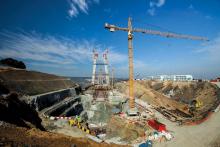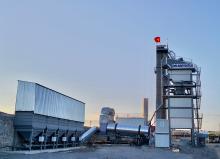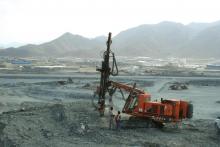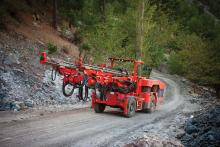By the end of 2018, a shiny new strip of asphalt will skirt around Turkey’s largest city, Istanbul, providing a new transport connection. The North Marmara Highway project is costing around US$2.43 billion to construct and will vastly improve Turkey’s own internal road transport links, as well as providing a better connection with Europe
On the European side of the Bosporus, the highway stretches 73km from Kinali, while on the Asian side it runs for 122km to Akyazi, where it will link with the tolled Otoyol 4 route. This new highway is designed to provide a more efficient transport route and utilises the new third Bridge over the Bosporus, which lies to the north of Istanbul. With the construction of the new highway this will help to speed transport in Turkey. This is because the route avoids Istanbul (one of the world’s most traffic-clogged cities), while the link will also connect with Istanbul’s massive new airport, currently under construction. And the highway also provides a better connection to the recently completed Osman Gazi Bridge, which stretches 2.7km over the Gulf of Izmit and provides a shorter route for traffic heading between Istanbul and the south of the country. As the North Marmara Highway joins with the Otoyol 4 route, also known as the Anatolia Motorway or Anadolu Otoloyu, this provides a connection with Turkey’s Central Anatolia Region, which includes the country’s capital, Ankara.
Work on the Asian stretch of the North Marmara Highway has been split into three sections, with the contracts being handled by three of Turkey’s biggest construction firms;
The 33km stretch being built by Cengiz features several technical and logistical challenges however. The comparatively remote nature of this stretch plus the uneven terrain combine to make it complex. Access is not straightforward as the existing roads are narrow and twisting, with highly degraded surfaces in many areas, a patchwork of potholes and temporary repairs.
Building the new link will afford drivers a faster and safer route that is better able to cope with Turkey’s increasing traffic volumes. In particular this will benefit the heavy trucks, many of which drive across the country’s borders, reinforcing Turkey’s long history as one of the world’s major hubs for trade and transport.
Trade and commerce were seen as cornerstones for Turkey’s future prosperity when the Turkish Republic was founded by its visionary leader Kemal Ataturk in the early 1920s. The focus on trade and transport has continued in more recent times, with the country investing heavily in developing its road and highway network over the past decade in particular. And the North Marmara Highway is one of several major new infrastructure projects being built at present.
Cengiz started work on its section of the North Marmara Highway at the end of 2016, commencing with its surveying work. The actual overburden removal and earthmoving portion of the project then started in the first quarter of 2017.
The contractor has a workforce of 520 onsite at present, but this is expected to ramp up to around 1,200 personnel by the end of August 2017. Meanwhile sub-contractors will further add to the workforce once the project reaches its peak. The firm was awarded its portion of the project under the build, operate and transfer model for only a few years. To achieve the best economic value, delivering the link in the shortest time will also allow Cengiz to maximise toll revenue.
At the moment, the earthmoving work is carried on a single shift basis and this extensive portion of the project is expected to take around two years to complete.
With this tight time schedule crucial for Cengiz, maintaining productivity is essential. Maximum uptime and utilisation of the equipment is essential to ensuring productivity targets are met, as the firm’s highly experienced equipment manager Asım Topçu explained. At present Cengiz has around 60
its peak. The firm’s Cat fleet presently includes 13 of the 962L loaders, eight TH414CGC telehandlers and six 326D2 excavators equipped
with breakers (with another 10 being supplied). The contractor is also using a number of Cat 966H wheeled loaders, 140M graders, 973 crawler loaders, 349D2 and 374F excavators and D8T and D9T dozers. Many of these units are brand new, having been supplied by Turkey’s Cat dealer Borusan Makina. Meanwhile the other Cat machines have come from contracts Cengiz has carried out in other countries, including Iraq and Azerbaijan.
Cengiz carries out its own maintenance and repairs on its Cat machine fleet, sourcing genuine parts from Borusan Makina and also using scheduled oil sampling to ensure any issues are spotted early. Cengiz is using the ProductLink and VisionLink systems for preventative maintenance, which helps optimise servicing of the Cat machines and further avoids the risk of unscheduled downtime.
Topçu said that machine availability and durability were the key issues for Cengiz when selecting its machine fleet. The firm is keen to optimise machine performance due to the need for productivity, which is why it opted to utilise proven construction equipment brands for the project.
Apart from the Cat units used for earthmoving, Cengiz is using
To assist with the overburden removal operation, Cengiz is using Atlas Copco Roc L8 and Roc D7 drilling rigs while local sub-contractor
The earthmoving work is extensive and Cengiz expects to have to remove around 20 million m3 of material in all, as well as shifting in 18 million m3 of fill. The firm’s 33km stretch of the highway covers undulating terrain, which is why there are 27 cuttings in all, two of which are particularly substantial.
Ceyhun Osmanolu is upper structures chief and he explained that there are also four sections of the highway that cross larger valleys and feature viaducts (meaning that there are eight viaducts in all as the highway has parallel roadways). In all, the four viaduct sections total some 3.6km in length (so with the parallel roadways the viaducts have a total length of 7.2km). Three of these viaduct stretches are being built using conventional methods, with the columns being built first and the prefabricated sections then being placed on top using cranes. Osmanolu said that the fourth viaduct section is substantially longer at 920m, with its highest column measuring 65m and explained that as a result, this is being built using the more complex mobile scaffolding system (MSS).
The difficulty of the terrain meant revisions to the original alignment were required. The biggest changes in this respect were the construction of two tunnel stretches, measuring 1km and 4km long, the latter linking with the section of highway being built by Kolin.
The tunnels are being driven using the widely accepted new Austrian tunnelling method (NATM). Both sections feature twin parallel tubes, meaning that Cengiz is boring a total of 10km of tunnels in all. The tunnels are expected to take around 12 months to complete.
To carry the multiple traffic lanes, the tunnels have face areas of around 240m2. Face excavation is being carried out in two shifts/day, using four or six stages, depending on the requirements set by the geological conditions. Cengiz is using Atlas Copco jumbo drilling equipment as well as Cat 326 D2 excavators equipped with hydraulic breakers to carry out the face advance work in the tunnels. Shotcreting and temporary meshing is being used to support the tunnel sides during the advance process.
Meanwhile mucking out is being achieved using Cat 966H wheeled loaders, which are used to load the on/off highway Volvo tipper trucks belonging to the 55 units from the Cengiz fleet working on the project.
The shotcreting work is carried out using a number of Putzmeister machines, while Cat TH414C GC telehandlers with personnel baskets are used for the placing and finishing work in the tunnels. The concrete for the shotcreting (as well as the civil structures) is being produced onsite by the two 120tonne/hour batching plants Cengiz has commissioned, one of which is sited at the firm’s project headquarters.
Work on the asphalt surfacing is now commencing and at the time of the World Highways visit, the 400tonne/hour capacity
alt joint will lie in the middle of one of the lanes so as to reduce the risk of premature wear.
Topçu said that the firm has considered using a material feeder for the pavers given the need for maximising productivity. However with the batching plant actually located onsite and the firm’s tipper trucks able to use either the highway alignment itself or temporary access roads rather than public roads, it was felt that asphalt supply logistics would not be a problem. In all, Cengiz expects to lay around 2 million m3 of asphalt, all of which will be produced by the Benninghoven plant.
To supply the aggregates for the project meanwhile, Cengiz is operating a quarry that is located close to the site. This quarry belongs to Turkey’s state-owned highway firm and has just been reopened specifically for the project. It now features a
Turkey’s massive infrastructure programme
Turkey’s multibillion Dollar investment in infrastructure is impressive. The country has recently completed two landmark bridges, the third Bosporus Bridge, and the Osman Gazi Bridge, with work on the 1915 Canakkale Bridge project, at Gallipoli, now commencing and due to open in 2023. The new Istanbul (third) airport is currently under construction and with its seven runways, it is intended to offer the largest passenger capacity of any airport in the world when it becomes operational. A new tunnel is being built under the Bosporus, while other massive highway projects are also underway.
The third Bosporus Bridge, or Yavaz Sultan Selim Bridge, cost US$2.5 billion to construct and joins Sariyer on the European bank of the Bosporus with Beykoz on the Asian side. Its landmark design features a 59.4m-wide deck and it carries dual rail lines as well as multiple traffic lanes for road traffic. Built by the IC Ictas – Astaldi joint venture, the structure was designed to withstand the severe earthquakes that afflict the region. Meanwhile the new Osman Gazi Bridge close to Izmit is every bit as imposing, a 2.7km-long suspension bridge featuring three lanes of traffic in either direction. This is now the fourth longest suspension bridge in the world.









